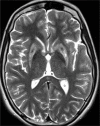Neurological features and management of Wilson disease in children: an evaluation of 12 cases
- PMID: 27103860
- PMCID: PMC4829162
- DOI: 10.5152/TurkPediatriArs.2016.3080
Neurological features and management of Wilson disease in children: an evaluation of 12 cases
Abstract
Aim: Wilson's disease is an autosomal recessive disorder of copper metabolism which leads to copper overload in different tissues of the body. The aim of this study was to present the neurologic features of Wilson's disease and to assess the clinical course of neurological findings in children receiving anti-copper treatment.
Material and methods: Twelve children with a diagnosis of Wilson's disease and findings of central nervous system involvement who were followed up in the Department of Pediatric Neurology and Pediatric Gastroenterology of the School of Medicine at Erciyes University were enrolled in the study.
Results: The study cases consisted of five boys (42%) and seven girls (58%). The mean age at the time of diagnosis was 9.9±3.4 years (5-15 years). The mean duration of follow-up was 49.0±36.4 months (15-128 months). Neurological findings at presentation included headache in seven cases (58%), tremor in seven cases (58%), dystonia in three cases (25%), ataxia in two cases (17%), dizziness in two cases (17%), numbness in the hands and acute weakness in one case (8%) and syncope in one case (8%). Headache, dizziness, syncope, numbness in hands and acute weakness symptoms resolved completely within six months after receiving treatment. Movement disorders either decreased or remained stable in seven of the eight cases. However, one patient developed progressively worsening dystonia despite to all treatments.
Conclusions: Wilson's disease can be manifested with signs and symptoms of central nervous system in the childhood. Wilson's disease should be considered in all children presenting with movement disorders. A complete neurological assessment should be carried out in all cases with Wilson's disease.
Keywords: Children; Wilson’s disease; movement disorders; neurotoxicity.
Figures
References
-
- Bull PC, Thomas GR, Rommens JM, Forbes JR, Cox DW. The Wilson disease gene is a putative copper transporting P-type ATPase similar to the Menkes gene. Nat Genet. 1993;5:327–37. http://dx.doi.org/10.1038/ng1293-327. - DOI - PubMed
-
- Roberts EA, Schilsky ML. Diagnosis and treatment of Wilson disease: an update. Hepatology. 2008;47:2089–111. http://dx.doi.org/10.1002/hep.22261. - DOI - PubMed
-
- El-Karaksy H, Fahmy M, El-Raziky MS, et al. A clinical study of Wilson’s disease: the experience of a single Egyptian Paediatric Hepatology Unit. Arab J Gastroenterol. 2011;12:125–30. http://dx.doi.org/10.1016/j.ajg.2011.07.007. - DOI - PubMed
-
- Patil M, Sheth KA, Krishnamurthy AC, Devarbhavi H. A review and current perspective on Wilson disease. J Clin Exp Hepatol. 2013;3:321–36. http://dx.doi.org/10.1016/j.jceh.2013.06.002. - DOI - PMC - PubMed
-
- Nicastro E, Ranucci G, Vajro P, Vegnente A, Iorio R. Reevaluation of the diagnostic criteria for Wilson disease in children with mild liver disease. Hepatology. 2010;52:1948–56. http://dx.doi.org/10.1002/hep.23910. - DOI - PubMed
LinkOut - more resources
Full Text Sources
Other Literature Sources


